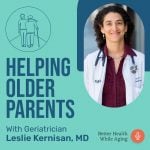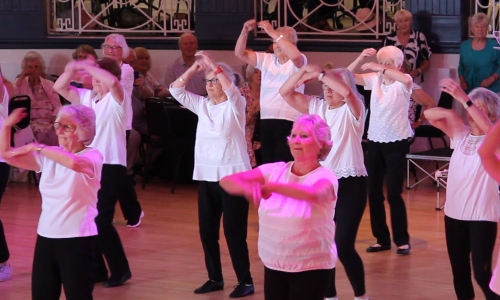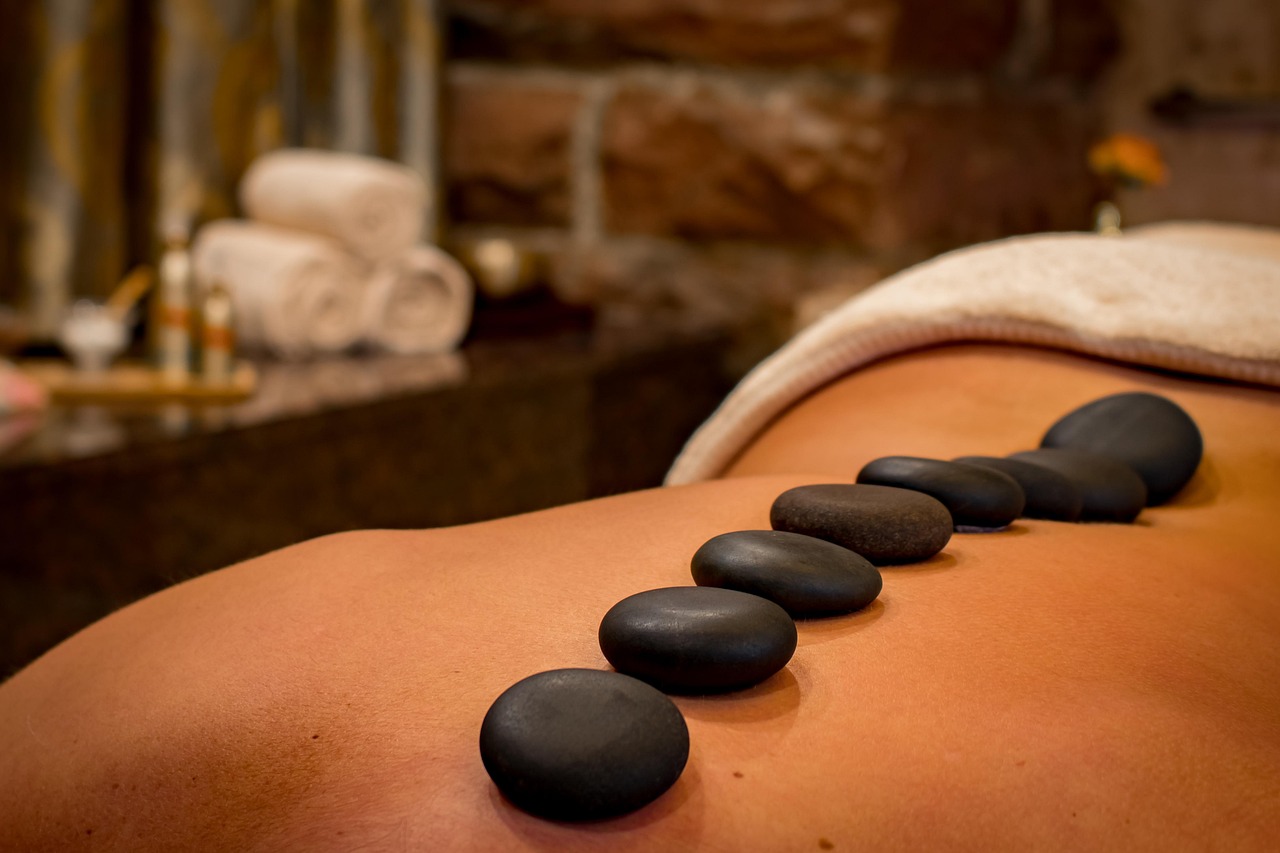

Do you find yourself taking stock and setting goals around the time of New Year’s?
It is indeed an excellent time to reflect on the past year.
And although one can set goals at any time of year, the start of the calendar year is a time that seems to inspire many people to think about their health and how to thrive over the coming year.
If better health while aging is important to you, here are my top ten suggestions for the coming year.
If you are in your sixties or older, you can consider these for your own healthy aging. Or, if you are concerned about an older parent’s health, you can help them address these over the coming year.
Just don’t resolve to address them all within the first few weeks of the year. Instead, it’s better to pace yourself, and pick 1-2 items to focus on each month.
10 Ways to Foster Better Health While Aging in 2025
1. Cultivate a positive attitude about your own aging. Did you know that more positive self-perceptions of aging have been repeatedly linked to better health?
In fact, a study published in 2023 found that older adults with mild cognitive impairment were significantly more likely to recover back to normal, if they had more positive self-perceptions of aging.
Because the evidence keeps finding benefits to having a more positive and accepting attitude about one’s aging, I’ve decided to make this a top recommendation this year.
Now you may be wondering: how to do this? This is a good question, because as you may have noticed, society unfortunately tends to bombard us with negativity around aging, which means many of us have internalized ageism.
But the good news is that our attitudes about aging can be improved, especially when we take time to examine our own attitudes, and if we are exposed to positive age stereotypes.
Now, you should know that changing your attitude about aging is not something you can do quickly by force of will; your attitude is largely in your subconscious, and in most cases it takes time and persistence to change deep-seated beliefs.
But what you can do this January is set an intention to cultivate a more positive attitude, and then see where that takes you.
(A mindfulness practice and acknowledging any fears you have about aging will also help you.)
Note: Be very careful about encouraging someone else to change their attitude about aging. If an older loved one is expressing negativity about aging, what they need is to feel heard and understood, and they won’t feel that way if you try to reassure them or press them to see the bright side. Instead, listen attentively and compassionately. Once they feel heard and understood, you can potentially gently ask them to share what they do find good about aging.
2. Strength train at least twice a week. I’ve heard a longevity expert say that if he had to pick just one thing to improve longevity, it would be resistance exercises, which explicitly cause the muscles to build strength.
Now, as an older person, you really want to make sure you are doing all four types of exercise: strength, endurance (also known as “cardio”), flexibility, and balance.
But research over recent years keeps finding that strength training (e.g. weight lifting or other exercises that strengthen muscles) is especially beneficial as we age. Without strength training, muscles weaken as we age, which can lead to anything from falls to difficulties with daily activities.
To maintain your muscles, combine strength training with adequate protein intake; this has been shown to improve muscle mass. I generally recommend aiming for 1.2 grams of protein per kilo of body weight (1 kilo = 2.2 pounds), per day.
I cover more on exercising to age well in this video:
3. Make sure you’re doing exercises that challenge leg strength and balance, for fall prevention. Poor leg strength and balance are a common cause of falls in older adults. So working to maintain this is especially important for those older adults who have either fallen over the past year, or feel afraid of falling.
Check on your strength and balance with these easy assessment tests: the Timed Up and Go, the Chair Rise, and the Four Stage Balance Test.
It’s best to do these with a professional, but you can also try them at home first, especially if another person is there to lend a hand.
If you seem low on strength or have poor balance, talk to your doctor or therapist about whether the Otago fall prevention exercises might be right for you. Another form of exercise proven to reduce falls is Tai Chi.
You can view videos showing the assessment exercises and the Otago exercises here.
You can also learn more about which forms of exercise are best maintaining mobility in this podcast episode, featuring geriatric physical therapist Tiffany Shubert: 052 – Maintaining Mobility & Preventing Falls in Aging: Myths & Truths.
4. Walk more. Walking can be an easy way for older adults to stay active. It’s also a form of exercise that can be easily combined with socializing: you can walk with a friend, or walk to visit a friend or other parts of your neighborhood.
Try using a step-tracker to find out how much you walk every day. You can use a low-tech pedometer, an activity bracelet such as a Fitbit, or a smartphone app.
Once you’ve figured out your average daily step count, make a plan to increase your walking by at least a little bit. A research study found that walking at least 6,000 steps/day was associated with less arthritis.
5. Protect your brain — and your balance — by avoiding medications known to dampen brain function. Proper attention to medications is one of the top three actions recommended by National Academies of Medicine, to protect cognitive health while aging.
(For more on how cognition changes with aging, see: 6 Ways that Memory & Thinking Change with Normal Aging & What to Do About This.)
That’s because research has linked such medications to worse cognitive function, and sometimes to the acceleration of cognitive decline.
Plus, most medications that are bad for the brain are also bad for balance. So there is a double benefit in spotting and minimizing these drugs.
And medications that affect the brain are more common than you might think: did you know that diphenhydramine (brand name Benadryl) slows brain function and might be associated with Alzheimer’s?
That’s because Benadryl, like MANY commonly used drugs, is quite anticholinergic. These medications really should come with a memory warning for older adults! But since they don’t, I’ve written about them here, or you can watch the video below to learn to spot the ones older adults use the most often.
For more proven strategies on maintaining brain health, see How to Promote Brain Health.
6. Deprescribe if possible! Review all medications and identify those that may be potentially inappropriate or unnecessary. According to the CDC, every year 600,000 older adults visit the emergency room due to medication problems. Research has also found that “inappropriate prescribing” of drugs is very common.
Although geriatricians especially worry about medications that affect the brain and balance, older adults are also often harmed by blood-thinners, medication for blood pressure, insulin and other medications that lower blood sugar, and non-steroidal anti-inflammatory painkillers (e.g. ibuprofen and naproxen).
To avoid excess risk or harm from medications, it’s best to periodically review the purpose and dosing of all medications. You will need to work with a doctor or pharmacist to do this, but it’s good to do a little homework beforehand. This helps ensure that nothing important falls through the cracks, and will help you better understand the treatment of your health conditions.
Learn a five-step process you can use here: How to Review Medications for Safety & Appropriateness in Aging.
You can also learn more about the most important medications to consider deprescribing here: Deprescribing: How to Be on Less Medication for Healthier Aging.
7. Start — or update — your personal health record. A personal health record is a way for you to keep your own copies of your own essential health information. This can be done with a paper file folder at home, or by keeping digital copies on your computer, or even by using a special service.
All your health information — which often comes from various doctors and clinics — should be kept in a single location that you control. (So accessing your records via your clinic’s patient portal is not the same thing as maintaining a personal health record.)
Personal health records can make it much easier for an older adult to quickly get the right care in the event of an emergency, a second opinion, or a change in doctors.
At a minimum, aim to get copies of all lab results and radiology results from the past two years.
For more on how to set up and maintain a personal health record, see this article: How to Use a Personal Health Record to Improve an Older Person’s Healthcare.
8. If you are on medication for high blood pressure, get a home blood pressure monitor and check your home blood pressure at least once a month.
High blood pressure is one of the most common conditions among older adults, but it’s surprisingly easy for it to be either over-treated (which can lead to falls) or under-treated (which can lead to strokes and heart problems).
Experts have long recommended that patients and doctors use home-based blood pressure measurements to guide care, because these are often more accurate than office-based measurements.
So if you haven’t already gotten in the habit of using a home blood pressure monitor, do it this year!
You can learn more about what to do here: 6 Steps to Better High Blood Pressure Treatment for Older Adults.
9.Be vaccinated against COVID (including the most recent booster), and take additional precautions when COVID levels are high.
I know: a lot of people — including many older adults — in the U.S. think it’s time to get over being careful about COVID.
I disagree! Because when we stop being careful about COVID, it’s older adults who disproportionately bear the consequences.
Now, I’m not advocating for a return to radical isolation measures, forgoing all social gatherings, or wearing masks everywhere forever.
But I believe it’s important that we continue to make an effort in 2025, as individuals and as a society, to reduce COVID transmission and to keep older adults up-to-date on their COVID vaccinations.
It’s true that COVID is less likely to hospitalize or kill a person than it used to be…in part because almost everyone has either had it or been vaccinated (or both).
But COVID remains risky for older adults, especially if they are older and frailer. During our most recent COVID wave (September 2024), we had over 1000 people per day dying of COVID, of which an estimated 90% of them were aged 65 or older.
(As of late December 2024, COVID levels in wastewater had been low but are starting to go up; we’ll probably have another wave in Jan/Feb.)
Vaccines do make a big difference in reducing COVID risk. But the protective effect wanes more quickly as people get older and frailer. This is why it’s important for older adults to be up-to-date on their COVID vaccines. (The most recent one available is the fall 2024 COVID vaccine.)
And even with a recent booster, anyone can still catch COVID, because the latest variants have evolved to dodge the antibodies that prevent infection. This doesn’t mean the vaccines and boosters don’t work; they definitely protect against severe COVID.
But if you want to avoid getting sick from COVID, or passing it along to someone else, then it’s important to take precautions when COVID rates are high.
For my recent updates on COVID vaccines, including a detailed review of how well they work in older adults, the data on boosters, and more, see here: COVID & Aging Adults: 2024-2025 Updates.
And then remember: if you are an older adult, don’t assume that being fully vaccinated and boosted means precautions are no longer needed. A recent booster provides an amazing level of protection, but a minority of older adults (mostly aged 80+) will still experience serious breakthroughs.
So especially when there is a COVID wave going (which has happened every winter in December and January), you’ll need to continue to wear masks, be cautious about indoor gatherings, and take common-sense precautions to reduce transmission and exposure.
As a society, we should also invest in cleaner indoor air, better COVID vaccines and treatments, and more.
Enough about dutifully checking one’s health & planning ahead! Here are the fun suggestions:
10. Socialize (safely!), contribute, and nourish your soul.
Research has confirmed what many already knew: relationships and contributing to the world are key to maintaining well-being while aging.
So reach out to others as often as you can. Invite a friend for a walk, or a cup of tea. Call your family members to say hello and ask how they are doing. Maintain connections to those you know and care about. And if you don’t have many connections, look for ways to meet people.
It’s also important to keep engaging in those activities that feel nourishing to one’s soul. Sometimes these involve other people, but they might also be things you do just for your own engagement and pleasure.
So this year, be sure to take stock of how much time you spend with others. If you realize you often feel isolated or lonely, find ways to connect more with others. You can also consider calling the Friendship Line, a special non-profit service dedicated to supporting lonely older adults.
It’s also good to consider ways to contribute. Volunteering can be an excellent way to connect while bringing purpose to one’s life, but sometimes part-time work or leadership engagements are an option too. CoGenerate.org (formerly Encore.org) is a wonderful organization helping people 50+ to contribute and collaborate with people of all ages.
And then take some time to think what activities bring you contentment and well-being. If you aren’t doing such activities at least a few times a week, ask yourself why. And then see what can be done about the whys.
Bonus idea: Brainstorm a life wishlist. Then go and do at least one thing on the list.
I was really touched a few years ago by the story of “Miss Norma,” who at age 90 left her long-time home to spend a year road-tripping with family.
Her story spoke to me of how it’s almost never too late to do something you’ve always wanted to do, or wished you could do.
In a similar vein, in 2019 and 2020 we had the story of Grandma Joy, who traveled the National Parks with her grandson.
So this year, I hope you’ll make a list of things you still want to do in your life. It could be a special trip, perhaps planned for a time of year when eating and socializing can happen outside. Or it could be something like reconciling with a family member, taking up a new hobby, or doing something else you’ve thought you’d love to do “someday.”
Write these down. Talk to family or friends about them.
And then make sure to do at least one.
Best wishes for the coming year!




